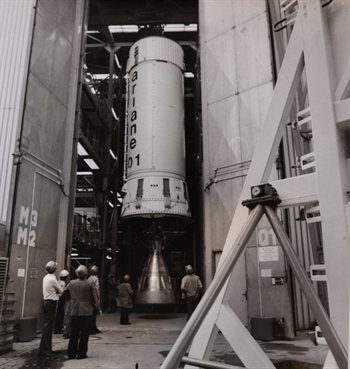Posted on 11 October 2013

Pawel Frankowski, Assistant Professor at the Maria Curie-Sklodowska University in Lublin, is conducting a research at the Historical Archives of the European Union on relations between the space policy of the European Union and the EU’s strategies in development cooperation. The research analyses the impact of the EU’s space policy on regional development in African countries and sheds light on how space policies can promote ideas of integration and foster technological change in developing countries.
Geographically, Africa has long been within the scope of European space activities as expressed in various strategic documents, such as “Space: a new European frontier for an expanding Union - An action plan for implementing the European Space policy (2003)”. European space activities are important for African countries in terms of security, cartography and the management of water and food resources. Cooperation in space has helped pave the way for economic development and regional integration in Africa.
“On the European side, outer space activities are excellent examples of European integration, where the European Space Agency is the primary actor. European states, coming together to reach the stars, are able to undertake technologically advanced and economically demanding operations, which are out of reach of any single European state,” states Dr. Frankowski.
Amongst European countries, space activities have initiated dialogue with integration and cooperation and the growing dependence on space technologies in essential sectors of the European economy has implications for European economy and security. Also, the European space policy has gradually shifted towards global activities and responsibilities.
“Without a detailed study of history of European cooperation in space, the analysis of European integration and global role of European Union is incomplete”, says Frankowski.
During his research, Frankowski analysed archival documents and ESA’s European oral history programme by means of the “voices” of the European outer space pioneers. While some interviewees emphasize the spirit of cooperation between the nations, others point to the rivalries between the USA and the Soviet Union and their vivid competition in cooperation with Europe. France and Germany are presented as partners but also as competitors. Most interviewees stress the role of personalities, such as André Lebeau or Roy Gibson for the progress of European space policy. Their personal stories tell about internal dynamics of space projects and the setting up of ESA; as Roy Gibson said: “A single man can move all the others”.
From the interviews, Frankowski learned that one of the main differences between European space activities and those of other institutions, such as NASA, is stability and predictability of the programmes. Apart from technical cooperation, ESA has been a binding force for its Member States and attracted countries outside the European Communities, such as Finland or Norway. A sign of success was when the Soviet Union and China became interested in ESA’s activities, so the cooperation and coordination between European countries has become a model for other regions in a globalised world.
So far, the origins of Europe in space have been considered rather from a scientific point of view. The new approach of this research is to trace back the European space politics and ideas. After successful attempts in outer space undertaken by the USSR and the US and the successful cooperation in Europe in the workings of the European Atomic and Energy Community (EAEC or EURATOM), Europe was ready to step into the new field of space activities. Politics became involved later and as such space policies even got mentioned in the final text of the Lisbon Treaty.
The initial European plans for space exploration were ambitious, and the early bodies, ELDO and ESRO, were soon replaced by the European Space Agency. While the scope of ESRO had been conceived as purely scientific, the European space activities quickly became political with nationalist tendencies sometimes prevailing. Nowadays ESA’s space activities have gone far beyond basic research towards applied research and outer space activities have almost become part of everyday life of Europeans, particularly when it comes to transportation, security, and weather forecasting. The definition of the European Union’s global role in space can boost economic activities and increase security in Europe. European space applications such as Copernikus/GMES and Galileo provide necessary data for a number of European projects.
“ESA is an example of successful hybrid cooperation, where EU and Non-EU member states are working together, coordinate and cooperate joint actions. The history of ESA tells us more about European integration than we can expect and without any doubt should it be an important part of the research agenda for everyone who studies integration mechanisms,” concludes Dr. Frankowski.
ESA began to consolidate its archives in 1989, with a ‘Contrat de dépôt’ signed with the EUI in Florence. In doing so, ESA had three objectives: to safeguard the heritage of its forerunners (COPERS, CETS, ESC, ELDO, ESRO), to provide a solid archival and historical base for research on the building of a European space power, and to promote its achievements through increased transparency regarding its decision-making process and the management of its programmes. The transfer of ESA archives to the HAEU is organised in annual shipments. The interviews for ESA’s European oral history programme have been deposited along with the paper archives at the HAEU. The oral history collection is expected to grow with further interviews.
Archival Fonds of the European Space Agency at the HAEU
Oral History of Europe in Space